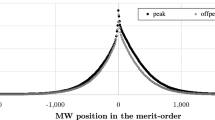Abstract
We present an empirical analysis of a supply function equilibrium model in the Texas spot electricity market. We derive conditions for optimal bidding behavior in a spot market with ex ante bilaterally contracted sales. By estimating costs, we are able to derive a set of ex post-and ex ante-optimal supply functions and use a non-parametric behavioral model to compare our theoretically optimal supply functions to actual offers made. Our results show that with the exception of the largest generators, firms make offers with markups and markdowns far in excess of what a model of profit-maximizing behavior suggests.
Similar content being viewed by others
References
Anderson, E. J., & Hu, X. (2005). finding supply function equilibria with asymmetric firms. Working Paper.
Baldick, R., Grant, R., & Kahn, E. (2000). Linear supply function equilibrium: generalizations, application, and limitations. UCEI POWER Working Paper PWP-078.
Baldick R., Grant R., Kahn E. (2004). Theory and application of linear supply function equilibrium in electricity markets. Journal of Regulatory Economics, 25, 143–167
Baldick, R., & Hogan, W. (2002). capacity constrained supply function equilibrium models for electricity markets: stability, non-decreasing constraints, and function space iterations. UCEI POWER Working Paper PWP-089.
Czyzyk J., Mesnier M.P., More J.J. (1998). The NEOS server. IEEE Journal on Computational Science and Enginerring, 5, 68–75
Fletcher, R., & Leyffer, S. (1999). User Manual for filterSQP. University of Dundee.
Green R. (1996). Increasing competition in the british electricity spot market. The Journal of Industrial Economics, 44, 205–216
Green R., Newbery D. (1992). Competition in the British electricity spot market. The Journal of Political Economy, 100, 929–953
Holmberg, P. (2004). Unique supply function equilibrium with capacity constraints. Uppsala Universitet Department of Economics Working Paper 2004:20.
Holmberg, P. (2005a). Asymmetric supply function equilibrium with constant marginal costs. Preliminary Version.
Holmbergm P. (2005b). Numerical calculation of an asymmetric supply function equilibrium with capacity constraints. Uppsala Universitet Department of Economics Working Paper 2005:12.
Hortaçsu, A., & Puller, S. L. (2005). testing models of strategic bidding in auctions: a case study of the texas electricity spot market. UCEI CSEM Working Paper 125.
Hurlbut D., Rogas K., Oren S.S. (2004). Protecting the market from Hockey Stick pricing: how the public utility commission of texas is dealing with potential price gouging. The Electricity Journal, 17, 26–33
Kim, D.-W., & Knittel, C. (2004). Biases in static oligopoly models? Evidence from the California electricity market. UCEI CSEM Working Paper 131.
Klemperer P.D., Meyer M.A. (1989). supply function equilibria in oligopoly under uncertainty. Econometrica, 56:1243–1277
Nadaraya E.A. (1964). On estimating regression. Theory of Probability and Its Applications, 9, 141–142
Newbery D. (1998). Competition, contracts, and entry in the electricity spot market. The RAND Journal of Economics, 29, 726–749
Niu, H. (2005). Models for electricity market efficiency and bidding strategy analysis. Ph.D. dissertation. Electrical and Computer Engineering Department, The University of Austin at Texas.
Rudkevich, A. (1999). Supply function equilibrium in power markets: Learning all the way. TCA Technical Report Number 1299-1702, Tabors Caramanis and Associates.
Speckman P.E. (1998). Kernel smoothing in partial linear models. Journal of the Royal Statistical Society, Series B (Methodological), 50, 413–436
von der Fehr N.H.M., Harbord D. (1993). Spot market competition in the uk electricity industry. The Economic Journal, 103, 531–546
Watson G.S. (1964). Smooth regression analysis. Sankhya—The Indian Journal of Statistics, Series A, 26, 359–372
Wilson R. (1979). Auctions of shares. Quarterly Journal of Economics, 93, 675–689
Wolak F.A. (2003). Measuring unilateral market power in wholesale electricity markets: The California Market 1998 to 2000. American Economic Review, 93, 426–430
Wolfram C. (1999). Measuring duopoly power in the british electricity spot market. American Economic Review, 89, 805–826
Author information
Authors and Affiliations
Corresponding author
Rights and permissions
About this article
Cite this article
Sioshansi, R., Oren, S. How good are supply function equilibrium models: an empirical analysis of the ERCOT balancing market. J Regul Econ 31, 1–35 (2007). https://doi.org/10.1007/s11149-006-9008-6
Published:
Issue Date:
DOI: https://doi.org/10.1007/s11149-006-9008-6




